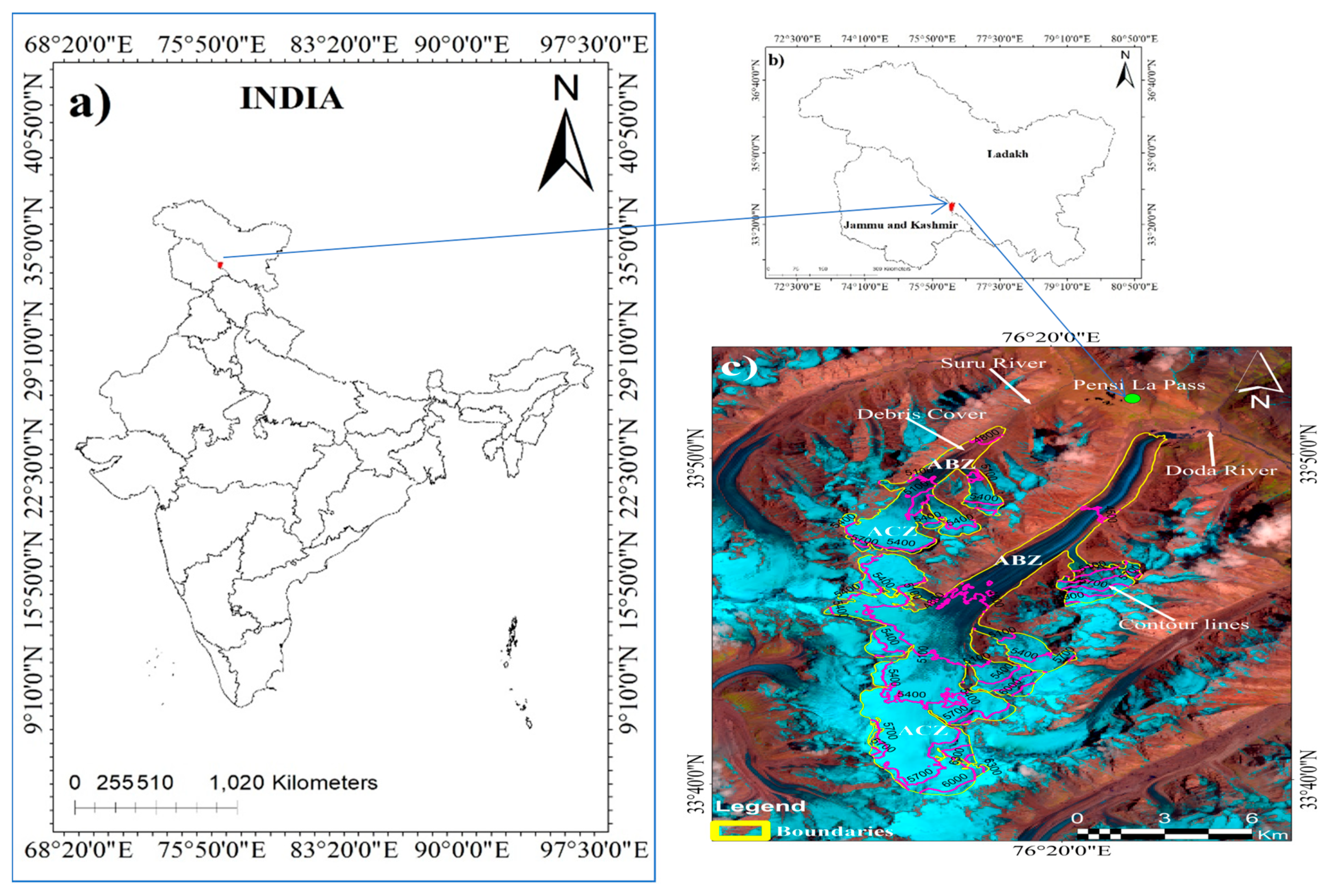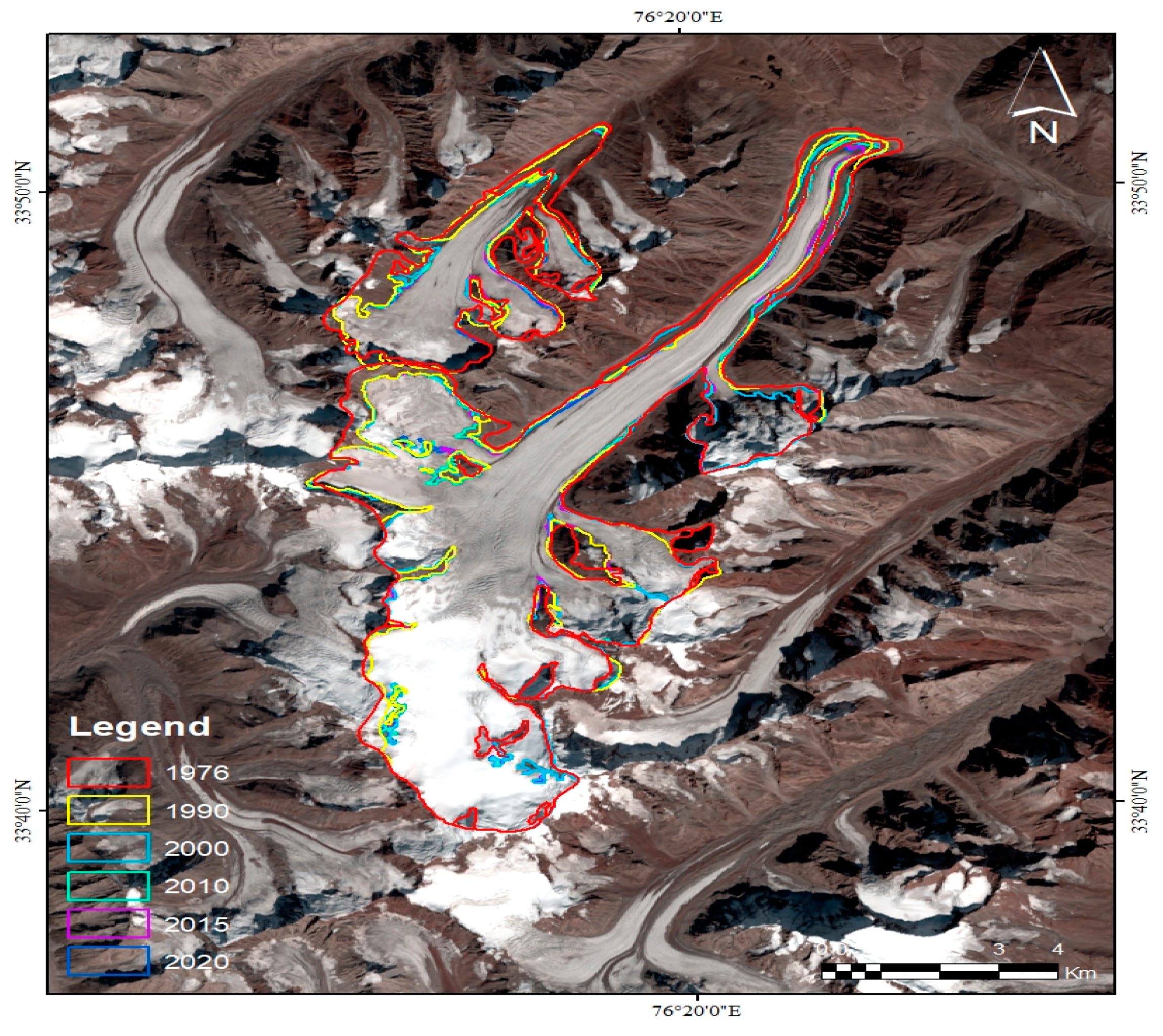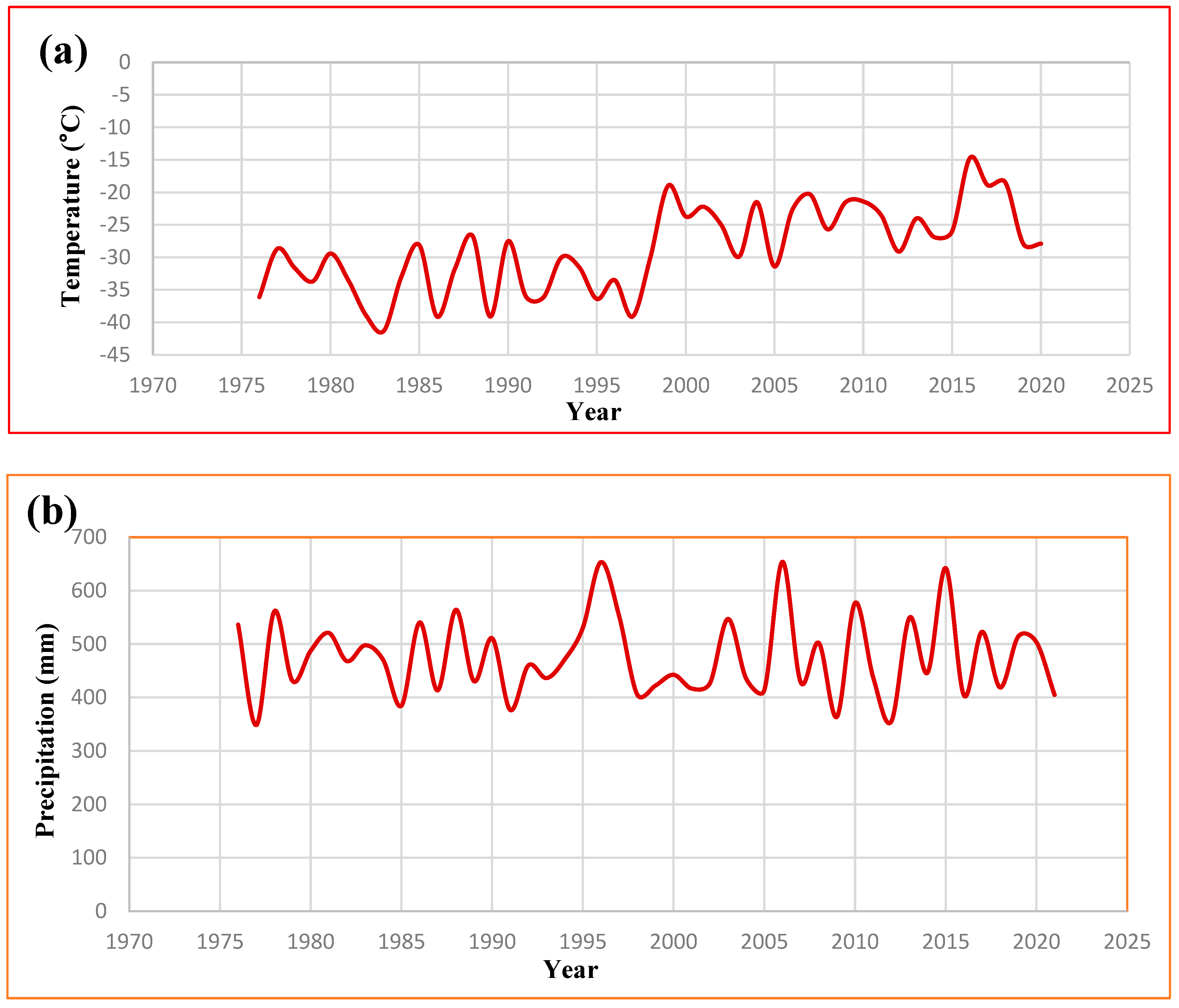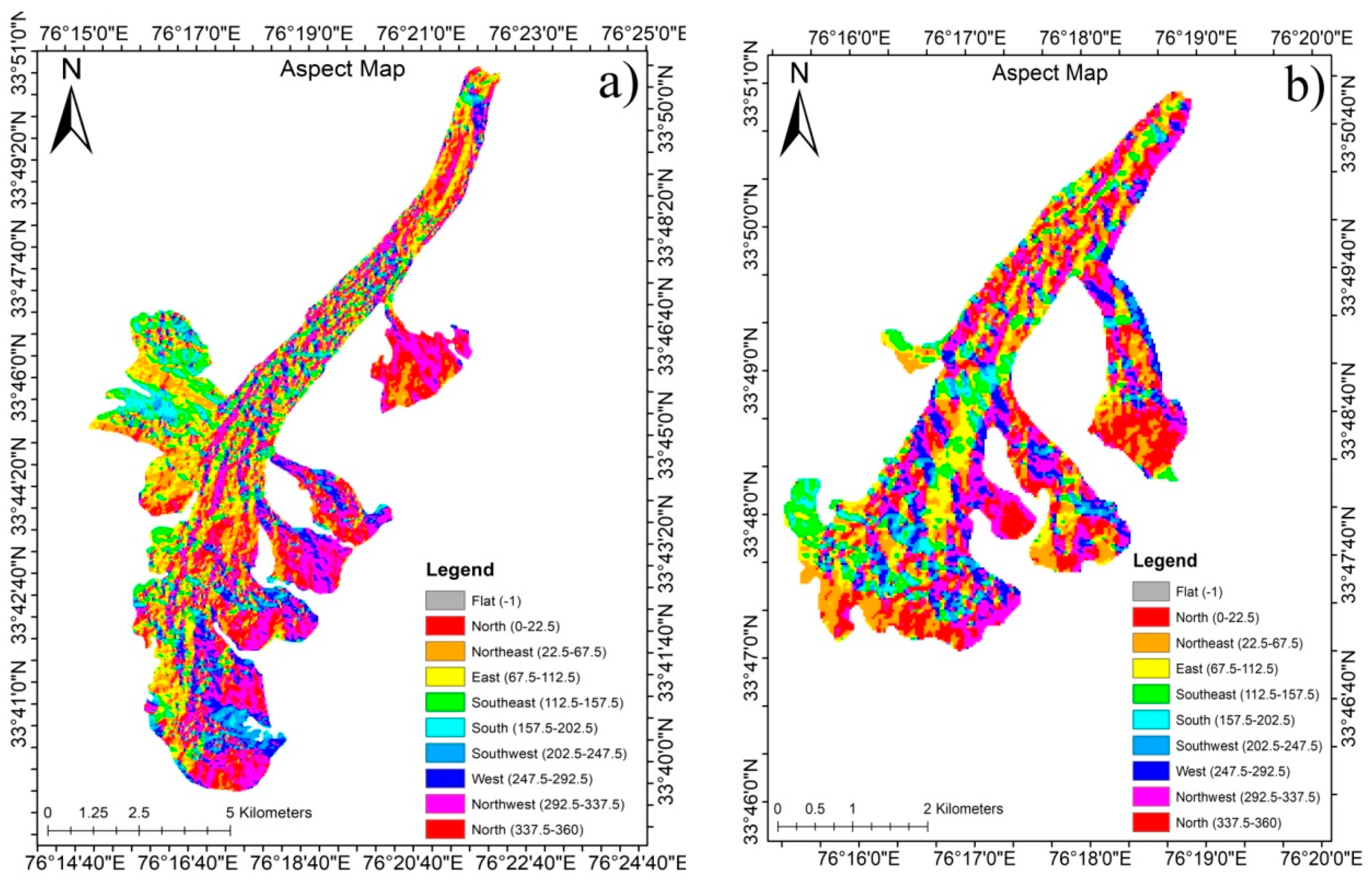Long-Term Geospatial Observations of the Drang Drung and Pensilungpa Glaciers, North Western Himalaya, India, from 1976 to 2020
Abstract
:1. Introduction
2. Materials and Methods
2.1. Study Area
2.2. Field Data
2.3. Remote Sensing Datasets
2.4. Methodology Adopted
2.5. Uncertainty Estimation
3. Results
3.1. Area Changes
3.2. Length Changes
3.3. Debris Cover Change
3.4. Snow Line Altitude/AAR
3.5. Impact of Climate on Glacier Changes
3.6. Mean Slope
3.7. Aspect
3.8. Hypsometry
4. Discussion
5. Conclusions
Author Contributions
Funding
Institutional Review Board Statement
Informed Consent Statement
Data Availability Statement
Acknowledgments
Conflicts of Interest
References
- Bolch, T.; Kulkarni, A.; Kääb, A.; Huggel, C.; Paul, F.; Cogley, J.G.; Frey, H.; Kargel, J.S.; Fujita, K.; Scheel, M.; et al. The state and fate of Himalayan glaciers. Science 2012, 336, 310–314. [Google Scholar] [CrossRef] [PubMed]
- Pritchard, H.D. Asia’s glaciers area regionally important buffer against drought. Nature 2017, 545, 169–174. [Google Scholar] [CrossRef] [PubMed]
- Mehta, M.; Dobhal, D.P.; Bisht, M.P.S. Change of Tipra glacier in the Garhwal Himalaya, India, between 1962 and 2008. Prog. Phys. Geogr. Earth Environ. 2011, 35, 721–738. [Google Scholar] [CrossRef]
- Shukla, A.; Ali, I.; Hasan, N.; Romshoo, S.A. Dimensional changes in the Kolahoi glacier from 1857 to 2014. Environ. Monit. Assess. 2016, 189, 5. [Google Scholar] [CrossRef] [PubMed]
- Kulkarni, A.V.; Rathore, B.P.; Singh, S.K.; Bahuguna, I.M. Understanding changes in the Himalayan cryosphere using remote sensing techniques. Int. J. Remote Sens. 2011, 32, 601–615. [Google Scholar] [CrossRef]
- Kulkarni, A.V.; Karyakarte, Y. Observed changes in Himalayan glaciers. Curr. Sci. 2014, 106, 237–244. [Google Scholar]
- Scherler, D.; Bookhagen, B.; Strecker, M.R. Hill slope-glacier coupling: The interplay of topography and glacial dynamics in High Asia. J. Geophys. Res. Earth Surf. 2011, 116, F2. [Google Scholar] [CrossRef]
- Stokes, C.R.; Popovnin, V.; Aleynikov, A.; Gurney, S.D.; Shahgedanova, M. Recent glacier retreat in the Caucasus Mountains, Russia, and associated increase in supra glacial debris cover and supra-/proglacial lake development. Ann. Glaciol. 2007, 46, 195–203. [Google Scholar] [CrossRef]
- Venkatesh, T.N.; Kulkarni, A.V.; Srinivasan, J. Relative effect of slope and equilibrium line altitude on the retreat of Himalayan glaciers. Cryosphere 2012, 6, 301–311. [Google Scholar] [CrossRef]
- Pandey, P.; Kulkarni, A.V.; Venkataraman, G. Remote sensing study of snowline altitude at the end of melting season, Chandra-Bhagabasin, Himachal Pradesh, 1980–2007. GeocartoInt 2013, 28, 311–322. [Google Scholar] [CrossRef]
- Chand, P.; Sharma, M.C. Glacier changes in the Ravi basin, North-Western Himalaya (India) during the last four decades (1971–2010/13). Glob. Planet. Chang. 2015, 135, 133–147. [Google Scholar] [CrossRef]
- Scherler, D.; Bookhagen, B.; Strecker, M.R. Spatially variable response of Himalayan glaciers to climate change affected by debris cover. Nat. Geosci. 2011, 4, 156–159. [Google Scholar] [CrossRef]
- Dobhal, D.P.; Mehta, M.; Srivastava, D. Influence of debris cover on terminus retreat and mass changes of Chorabari Glacier, Garhwal region, central Himalaya, India. J. Glaciol. 2013, 59, 961–971. [Google Scholar] [CrossRef]
- Shukla, A.; Qadir, J. Differential response of glaciers with varying debris cover extent: Evidence from changing glacier parameters. Int. J. Remote Sens. 2016, 37, 2453–2479. [Google Scholar] [CrossRef]
- O’Neal, M.A.; Hanson, B.; Carisio, S.; Satinsky, A. Detecting recent changes in the areal extent of North Cascades glaciers, USA. Quat. Res. 2015, 84, 151–158. [Google Scholar] [CrossRef]
- Davies, B.J.; Carrivick, J.L.; Glasser, N.F.; Hambrey, M.J.; Smellie, J.S. A new glacier inventory for 2009 reveals spatial and temporal variability in glacier response to atmospheric warming in the northern Antarctic Peninsula, 1988–2009. Cryosphere Discuss. 2011, 5, 3541–3595. [Google Scholar] [CrossRef]
- Furbish, D.J.; Andrews, J.T. The use of hypsometry to indicate long-term stability and response of valley glaciers to changes in mass transfer. J. Glaciol. 1984, 30, 199–211. [Google Scholar] [CrossRef]
- Jiskoot, H.; Curran, C.J.; Tessler, D.L.; Shenton, L.R. Changes in Clemenceau Ice field and Chaba Group glaciers, Canada, related to hypsometry, tributary detachment, length–slope and area–aspect relations. Ann. Glaciol. 2009, 50, 133–143. [Google Scholar] [CrossRef]
- Fountain, A.G.; Hoffman, M.J.; Granshaw, F.; Riedel, J. The “benchmarkglacier” concept—Does it work? Lessons from the North Cascade Range, USA. Ann. Glaciol. 2009, 50, 163–168. [Google Scholar] [CrossRef]
- Raman, A.; Kulkarni, A.V.; Prasad, V. Glacier mass balance estimation in Garhwal Himalaya using improved accumulation area ratio method. Environ. Monit. Assess. 2022, 194, 583. [Google Scholar] [CrossRef]
- Kamp, U.; Byrne, M.; Bolch, T. Glacier fluctuations between 1975 and 2008 in the Greater Himalaya Range of Zanskar, southern Ladakh. J. Mt. Sci. 2011, 8, 374–389. [Google Scholar] [CrossRef]
- Shukla, A.; Garg, P.K. Evolution of a debris-covered glacier in the western Himalaya during the last four decades (1971–2016): A multiparametric assessment using remote sensing and field observations. Geomorphology. 2019, 341, 1–14. [Google Scholar] [CrossRef]
- Bhambri, R.; Bolch, T.; Chaujar, R.K.; Kulshreshtha, S.C. Glacier changes in the Garhwal Himalaya, India, from 1968 to 2006 based on remote sensing. J. Glaciol. 2011, 57, 543–556. [Google Scholar] [CrossRef]
- Hanshaw, M.N.; Bookhagen, B. Glacial areas, lake areas, and snowlines from 1975 to 2012: Status of the Cordillera Vilcanota, including the Quelccaya Ice Cap, northerncentral Andes, Peru. Cryosphere 2014, 8, 359–376. [Google Scholar] [CrossRef]
- Racoviteanu, A.E.; Arnaud, Y.; Williams, M.W.; Manley, W.F. Spatial patterns in glacier characteristics and area changes from 1962 to 2006 in the Kanchenjunga–Sikkimarea, eastern Himalaya. Cryosphere 2015, 9, 505–523. [Google Scholar] [CrossRef]
- McFadden, E.M.; Ramage, J.; Rodbell, D.T. Landsat TM and ETM+ derived snow-line altitudes in the Cordillera Huayhuashand Cordillera Raura, Peru, 1986–2005. Cryosphere 2011, 5, 419–430. [Google Scholar] [CrossRef]
- Berthier, E.; Arnaud, Y.; Kumar, R.; Ahmad, S.; Wagnon, P.; Chevallier, P. Remote sensing estimates of glacier mass balances in the Himachal Pradesh (Western Himalaya, India). Remote Sens. Environ. 2007, 108, 327–338. [Google Scholar] [CrossRef]
- Kääb, A.; Berthier, E.; Nuth, C.; Gardelle, J.; Arnaud, Y. Contrasting patterns of early twenty- first- century glacier mass change in the Himalayas. Nature 2012, 488, 7412. [Google Scholar] [CrossRef]
- Tachikawa, T.; Kaku, M.; Iwasaki, A.; Gesch, D.; Oimoen, M.; Zhang, Z.; Danielson, J.; Krieger, T.; Curtis, B.; Haase, J. ASTER Global Digital Elevation Model Version 2-Summary of Validation Results. 31 August 2011. Available online: https://lpdaac.usgs.gov/documents/220/Summary_GDEM2_validation_report_final.pdf (accessed on 20 November 2022).
- Nagai, H.; Fujita, K.; Nuimura, T.; Sakai, A. Southwest–facing slopes control the formation of debris- covered glaciers in the Bhutan Himalaya. Cryosphere 2013, 7, 1303–1314. [Google Scholar] [CrossRef]
- Bolch, T.; Menounos, B.; Wheate, R. Landsat- based inventory of glaciers in western Canada, 1985–2005. Remote Sens. Environ. 2010, 114, 127–137. [Google Scholar] [CrossRef]
- DeBeer, C.M.; Sharp, M.J. Topographic influences on recent changes of very small glaciers in the Monashee Mountains, British Columbia, Canada. J. Glaciol. 2009, 55, 691–700. [Google Scholar] [CrossRef]
- Bhambri, R.; Bolch, T.; Chaujar, R.K. Frontal recession of Gangotri Glacier, Garhwal Himalayas, from 1965 to 2006, measured through high-resolution remote sensing data. Curr. Sci. 2012, 102, 489–494. [Google Scholar]
- Bhattacharya, A.; Bolch, T.; Mukherjee, K.; Pieczonka, T.; Kropáček, J.; Buchroithner, M.F. Overall recession and mass budget of Gangotri Glacier, Garhwal Himalayas, from 1965 to 2015 using remote sensing data. J. Glaciol. 2016, 62, 1115–1133. [Google Scholar] [CrossRef]
- Rabatel, A.; Francou, B.; Soruco, A.; Gomez, J.; Cáceres, B.; Ceballos, J.L.; Basantes, R.; Vuille, M.; Sicart, J.-E.; Huggel, C. Current state of glaciers in the tropical Andes: A multi –century perspective on glacier evolution and climate change. Cryosphere 2013, 7, 81–102. [Google Scholar] [CrossRef]
- Garg, P.K.; Yadav, J.S.; Rai, S.K.; Shukla, A. Mass balance and morphological evolution of the Dokriani Glacier, central Himalaya, India during 1999–2014. Geosci. Front. 2022, 13, 101290. [Google Scholar] [CrossRef]
- Paul, F.; Huggel, C.; Kääb, A. Combining satellite multispectral image data and a digital elevation model for mapping debris- covered glaciers. Remote Sens. Environ. 2004, 89, 510–518. [Google Scholar] [CrossRef]
- Racoviteanu, A.E.; Arnaud, Y.; Williams, M.W.; Ordoñez, J. Decadal changes in glacier parameters in the Cordillera Blanca, Peru, derived from remote sensing. J. Glaciol. 2008, 54, 499–510. [Google Scholar] [CrossRef]
- Hall, D.K.; Bayr, K.J.; Schöner, W.; Bindschadler, R.A.; Chien, J.Y.L. Consideration of the errors inherent in mapping historical glacier positions in Austria from the ground and space (1893–2001). Remote Sens. Environ. 2003, 86, 566–577. [Google Scholar] [CrossRef]
- Guo, Z.N.; Wanga, N.M.; Kehrwald, R.; Mao, H.; Wua, Y.; Jiang, W.X. Temporal and Spatial Changes in Western Himalayan Firn Line Altitudes from 1998 to 2009. Glob. Planet. Chang. 2014, 118, 97–105. [Google Scholar] [CrossRef]
- Banerjee, A.; Azam, M.F. Temperature reconstruction from glacier length fluctuations in the Himalayas. Ann. Glaciol. 2016, 57, 189–198. [Google Scholar] [CrossRef]
- Banerjee, A.; Shankar, R. On the response of Himalayan glaciers to climate change. J. Glaciol. 2013, 59, 480–490. [Google Scholar] [CrossRef]
- Fujita, K.; Nuimura, T. Spatially heterogeneous wastage of Himalayan glaciers. Proc. Natl. Acad. Sci. USA 2011, 108, 14011–14014. [Google Scholar] [CrossRef] [PubMed]
- Kumar, V.; Mehta, M.; Shukla, A.; Kumar, A.; Garg, S. Late Quaternary glacial advances and equilibrium –line altitude changes in a semi-arid region, Suru Basin, western Himalaya. Quat. Sci. Rev. 2021, 267, 107100. [Google Scholar] [CrossRef]
- Mehta, M.; Kumar, V.; Garg, S.; Shukla, A. Little ice age glacier extent and temporal changes in annual mass balance (2016–2019) of Pensilungpa Glacier, Zanskar Himalaya. Reg. Environ. Chang. 2021, 21, 38. [Google Scholar] [CrossRef]
- Brun, F.; Wagnon, P.; Berthier, E.; Jomelli, V.; Maharjan, S.B.; Shrestha, F.; Kraaijenbrink, P.D.A. Heterogeneous influence of glacier morphology on the mass balance variability in High Mountain Asia. J. Geophys. Res. Earth Surf. 2019, 124, 1331–1345. [Google Scholar] [CrossRef]
- Rounce, D.R.; King, O.; McCarthy, M.; Shean, D.E.; Salerno, F. Quantifying debris thickness of debris- covered glaciers in the Everest region of Nepal through inversion of a sub debris melt model. J. Geophys. Res. Earth Surf. 2018, 123, 1094–1115. [Google Scholar] [CrossRef]
- Brocklehurst, S.; Whipple, K. Hypsometry of glaciated landscapes. Earth Surf. Process. Landf. 2004, 29, 907926. [Google Scholar] [CrossRef]
- Harrison, W.D.; Elsberg, D.H.; Echelmeyer, K.A.; Krimmel, R.M. On the characterization of glacier response by a single time-scale. J. Glaciol. 2001, 47, 659–664. [Google Scholar] [CrossRef]
- Kraaijenbrink, P.; Meijer, S.W.; Shea, J.M.; Pellicciotti, F.; DeJong, S.M.D.; Immerzeel, W.W. Seasonal surface velocities of a Himalayan glacier derived by automated correlation of unmanned aerial vehicle imagery. Ann. Glaciol. 2016, 57, 103–113. [Google Scholar] [CrossRef]
- Kumar, V.; Mehta, M.; Mishra, A.; Trivedi, A. Temporal fluctuations and frontal area change of Bangni and Dunagiri glaciers from 1962 to 2013, Dhauliganga Basin, central Himalaya, India. Geomorphology 2017, 284, 88–98. [Google Scholar] [CrossRef]
- Mehta, M.; Kumar, V.; Kunmar, P.; Sain, K. Response of the thick and thin debris- covered glaciers between 1971 and 2019 in Ladakh Himalaya, India—A case study from Pensilungpa and Durung-Drung glaciers. Sustainability 2023, 15, 5. [Google Scholar] [CrossRef]
- Pandey, A.C.; Ghosh, S.; Nathawat, M.S. Evaluating patterns of temporal glacier changes in Greater Himalayan Range, Jammu & Kashmir, India. Geocarto Int. 2011, 26, 321–338. [Google Scholar]
- Bahuguna, I.; Rathore, B.; Brahmbhatt, R.; Sharma, M.; Dhar, S.; Randhawa, S.; Kumar, K.; Romshoo, S.; Shah, R.; Ganjoo, R. Are the Himalayan glaciers retreating? Curr. Sci. 2014, 106, 1008–1013. [Google Scholar]












| Data | Date/Year of Acquisition | Scene/ID | Spatial Resolution |
|---|---|---|---|
| Landsat 2 | 11/09/1976 | LM21590361976255FAK03 | 60 m |
| Landsat 5 | 20/09/1990 | LT51480371990263ISP00 | 30 m |
| Landsat 7 | 08/09/2000 | LE71480372000248SGS00 | 30 m |
| Landsat 5 | 21/09/2010 | LT51480372010264KHC00 | 30 m |
| Landsat 8 | 08/09/2015 | LC81480372015252LGN01 | 30 m |
| Landsat 8 | 19/09/2020 | LC81480372020263LGN00 | 30 m |
| Aster GDEM | 2016 | astgtmv003_n35e135 | 30 m |
| SRTM DEM | February 2000 | n33_e076_1arc_v3 | 30 m |
| Period | Error |
|---|---|
| 1976–1990 | ±19.83 |
| 1990–2000 | ±54.09 |
| 2000–2010 | ±36.28 |
| 2010–2015 | ±35.15 |
| 2015–2020 | ±47.38 |
Disclaimer/Publisher’s Note: The statements, opinions and data contained in all publications are solely those of the individual author(s) and contributor(s) and not of MDPI and/or the editor(s). MDPI and/or the editor(s) disclaim responsibility for any injury to people or property resulting from any ideas, methods, instructions or products referred to in the content. |
© 2023 by the authors. Licensee MDPI, Basel, Switzerland. This article is an open access article distributed under the terms and conditions of the Creative Commons Attribution (CC BY) license (https://creativecommons.org/licenses/by/4.0/).
Share and Cite
Jasrotia, A.S.; Ahmad, S.; Thakur, P.K.; Ridwan, Q.; Wani, Z.A.; Alamri, S.A.M.; Siddiqui, S.; Moustafa, M. Long-Term Geospatial Observations of the Drang Drung and Pensilungpa Glaciers, North Western Himalaya, India, from 1976 to 2020. Sustainability 2023, 15, 15067. https://doi.org/10.3390/su152015067
Jasrotia AS, Ahmad S, Thakur PK, Ridwan Q, Wani ZA, Alamri SAM, Siddiqui S, Moustafa M. Long-Term Geospatial Observations of the Drang Drung and Pensilungpa Glaciers, North Western Himalaya, India, from 1976 to 2020. Sustainability. 2023; 15(20):15067. https://doi.org/10.3390/su152015067
Chicago/Turabian StyleJasrotia, Avtar Singh, Suhail Ahmad, Praveen Kumar Thakur, Qamer Ridwan, Zishan Ahmad Wani, Saad Abdurahamn M. Alamri, Sazada Siddiqui, and Mahmoud Moustafa. 2023. "Long-Term Geospatial Observations of the Drang Drung and Pensilungpa Glaciers, North Western Himalaya, India, from 1976 to 2020" Sustainability 15, no. 20: 15067. https://doi.org/10.3390/su152015067
APA StyleJasrotia, A. S., Ahmad, S., Thakur, P. K., Ridwan, Q., Wani, Z. A., Alamri, S. A. M., Siddiqui, S., & Moustafa, M. (2023). Long-Term Geospatial Observations of the Drang Drung and Pensilungpa Glaciers, North Western Himalaya, India, from 1976 to 2020. Sustainability, 15(20), 15067. https://doi.org/10.3390/su152015067






